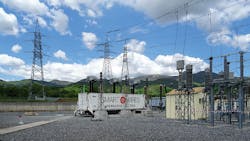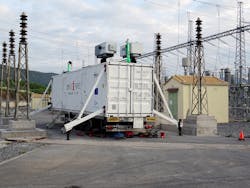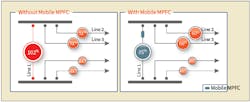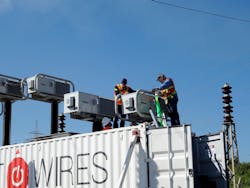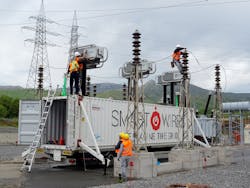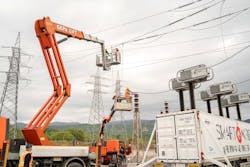Greece Manages Congestion on the Grid
The significant increase in renewable generation across Europe fundamentally is changing the way in which transmission system operators (TSOs) approach the design and operation of transmission systems. Independent Power Transmission Operator (IPTO), Greece’s transmission system operator, has set an enterprise goal to be one of the most efficient electricity TSOs in Europe. To achieve this goal while managing the energy transition is a complex challenge that requires innovation.
System congestion from increased levels of renewable energy is a well-known problem for TSOs worldwide. Today, the Greek Peloponnese region is served solely by a 150-kV transmission system and, because of the possible congestion issues in this area, the addition of new renewable energy projects has slowed down. More importantly, on the Greek system, the growing penetration of renewable energy in other regions could cause significant congestion elsewhere on the transmission system.
Renewable curtailment is a plausible option to alleviate congestion, but it would require system operators to dispatch expensive generation from other parts of the transmission system to meet customer demand. This action could result in increased bills for customers, higher carbon dioxide emissions and, if not resolved, depressed developer interest in future installations of renewable generation.
To enhance and accelerate the integration of renewables into the Greek power system while preventing possible curtailment of renewable generation in the future, IPTO is testing mobile modular power flow control (MPFC) technology.
MPFC technology allows TSOs to control power flow on their transmission lines. By changing the line’s impedance, power can be pushed off congested overhead lines and onto underutilized lines. This solution allows TSOs to capture the excess capacity currently available on the transmission system. Strategically installing MPFC on a transmission system can lower the investment required to accommodate a higher penetration of renewable generation and shorten the time it takes to bring renewable projects on-line.
A deployment of MPFC technology typically includes multiple devices per phase connected in series with the line. Each device operates either in injection mode or monitoring mode. In injection mode, each MPFC device injects a voltage in quadrature with the line current that modifies the line reactance. In monitoring mode, the current passes through the device but the line reactance is unaffected. The maximum injected reactance can be increased by adding more devices in series. These devices do not have the negative characteristics of passive devices such as the risk of sub-synchronous resonance (SSR) with series capacitors and the constant volt-ampere reactive (VAR) consumption of series reactors.
These devices are modular, allowing for an incremental investment strategy; quickly deployable, shortening the planning and installation cycle from years to weeks; and easily removable and redeployable, enabling transmission owners to respond to the changing needs of their grid.
Testing and Deployment
Flexible MPFC solutions dynamically control a transmission line’s impedance, effectively controlling the power flow on a given line. The degree of control can vary in accordance with the real-time needs of the grid, which can increase overall system utilization without requiring large infrastructure reinforcements.
IPTO installed the mobile MPFC technology from Smart Wires Inc. in the Peloponnese region of Greece. The installation is part of a European-funded research project called FLEXITRANSTORE, part of the European Commission’s Horizon 2020 framework.
IPTO determined where to install the mobile MPFC based on simulations using Siemens PSS/E grid planning software. After identifying a post-contingency overload, IPTO modeled the mobile MPFC on one of two 150-kV parallel single-circuit overhead transmission lines by increasing the circuit’s impedance. The results of this study indicated a deployment of mobile MPFC could reduce loading on the selected transmission line by 17%.
The mobile MPFC increases the impedance of the transmission line, effectively pushing power off that line. The thermal overload is resolved by leveraging spare capacity that exists on underutilized lines.
Following identification of the overloaded transmission line, substations on both sides of the 150-kV transmission line were evaluated to determine the optimal deployment site for the mobile MPFC solution. The substations were evaluated for installation feasibility in terms of slope, site surface materials, configuration of the overhead line conductors and overall substation configuration. Once the preferred site was chosen, the teams developed plans to connect the mobile MPFC unit to the transmission line and the substation ground grid. The site preparation work included conducting a complete site survey.
Installing the MPFC
After delivery to the substation, the following major steps were taken to install the mobile MPFC unit were as follows:
- Trained crew members used a power drill to deploy the trailer outriggers. The Smart Wires power flow control devices then were elevated to achieve the appropriate electrical safety clearances.
- The crew attached corona rings and completed the electrical connections between the devices. Steps 1 and 2 were completed with the transmission line in service.
- With the overhead transmission line isolated and grounded, the IPTO crew connected each phase conductor to the outer pads of the Smart Wires power flow control devices. A bucket truck was used in this procedure to install the connections to the overhead lines.
Connecting to the overhead lines required the temporary installation of poles to support the physical connections (jumpers) from the transmission line. Because of space considerations, IPTO needed to tap into the overhead transmission line mid-span, where the overhead line transitions from a vertical-stacked to a horizontal configuration at the substation gantry. These spatial and configuration challenges led the team to develop this alternative method of tapping into the overhead line while maintaining the necessary phase-to-phase electrical safety clearances.
Overall, the entire installation process took five days, one bucket truck and an eight-person field crew—four from IPTO and four from Smart Wires. The outage on the overhead line was less than 24 hours, spread across two working days. For other utilities considering deployment of this technology, site characteristics such as the slope of the site, site surface materials (bare earth, gravel or concrete), configuration of the overhead line conductors, bus bar structure and other factors impact the total installation time.
With IPTO’s assistance, Smart Wires incorporated learning benefits from this project into its technology development process, including the removal of internal lifting systems in favor of externally lifting multiple devices and insulator frames. Compared with the 2.3-MVAR unit installed at IPTO, the commercially available mobile MPFC is a 15-MVAR unit that can be installed on system voltages up to 275 kV and set up in four hours by a crew of four workers. Leveraging an on-site crane can make this process even faster. Additional mobile MPFC solutions of different values continue to be developed based on market interest.
IPTO also has gained valuable experience from the close collaborative relationship with Smart Wires throughout the site identification, feasibility and planning, installation and operational phases of the deployment.
European Showcase
By showcasing mobile MPFC technology in southeast Europe, this project is expected to be of great interest to the European Commission. The European Network of Transmission System Operators for Electricity (ENTSO-E) has indicated the main drivers for investments in this region are its high potential for solar generation combined with an existing transmission system that needs further development. This IPTO project, which relieves network congestion to enable higher renewable generation delivery, not only provides experience with mobile MPFC but also addresses some of the regional network challenges identified by ENTSO-E.
The mobile MPFC project aims to showcase the value of dynamically controlling line reactance and leveraging advanced methods for scheduling this capability in transmission planning processes. These findings are relevant for both TSOs and distribution system operators. Both systems can benefit from flexible planning and operational tools that enable better utilization of existing network capacity, as this reduces the impact of new infrastructure on communities and the environment.
IPTO is excited to gain experience with solutions like this innovative technology. Participating in the FLEXITRANSTORE project will ensure its learnings on mobile MPFC are shared broadly across Europe. IPTO aims to help cost-effectively transform the transmission system to meet the European Union’s 2050 goal of reducing greenhouse gas emissions by 80% to 95% compared to 1990 levels. MPFC is highly aligned with this long-term goal and there is great potential for MPFC to address a range of current and future challenges across European electric grids.
After IPTO gains sufficient operational experience, this mobile MPFC solution will be decommissioned from its transmission system and moved to the electricity system operator of Bulgaria. In its second location, the mobile MPFC will help to relieve another system constraint that is limiting renewable connections. Utilities also can leverage this trailer-based solution to manage short-term challenges, such as resolving transmission line overloads to enable outage windows for critical construction and maintenance works.
Acknowledgement
The authors wish to express their sincere thanks to Casey Heier, director of mobile solutions at Smart Wires, and Martin Jones, a consultant, for their help and support in preparing this article.
For more information:
Independent Power Transmission Operator | www.admie.gr
Smart Wires | www.smartwires.com
FLEXITRANSTORE, a Horizon 2020 Project
Horizon 2020 is a European Commission-funded initiative supporting collaborative research and innovation projects, involving at least three organisations from different countries in the European Union that form a consortium. The strategic objectives of the FLEXITRANSTORE consortium—which received funding through the Horizon 2020 program under Grant Agreement No. 774407—are to enhance and accelerate the integration of renewables into the European energy system and increase cross-border electricity flows in Europe.
To meet these two goals, flexibility is essential. Within the FLEXITRANSTORE project, flexible energy grid (FEG) components, innovative grid technologies and digital market infrastructures are being demonstrated at eight different test sites in five countries, including Bulgaria, Cyprus, Greece, Slovenia and Spain.
About the Author
George Papaioannou
George Papaioannou has BSME and MSME degrees from Stevens Institute of Technology in Hoboken, New Jersey, U.S., a PhD degree in applied mathematics from the University of Patras in Greece, a bachelor’s degree in social sciences from the London School of Economics and Political Science, a postgraduate diploma in management from the Henley business school at the University of Reading in the United Kingdom, and an ExCer in strategy from the London Business School in the United Kingdom. Papaioannou, who is now the director of research, technology, and development for the Independent Power Transmission Operator in Greece, has accumulated almost 40 years of work experience in the energy sector, both in academia and industry.
Christos Dikaiakos
Christos Dikaiakos has a MSEE degree and a PhD degree in electrical engineering from the University of Patras in Greece and also holds a master’s degree in energy and production management from the National Technical University of Athens, Greece. Dikaiakos is head of section planning and management of research and development projects in the research, technology, and development department of the Independent Power Transmission Operator in Greece. Previously, he worked at Netcom and Intracom Defense Electronic Systems.
Michalis E. Karystianos
Michalis E. Karystianos received a diploma degree in electrical and computer engineering as well as a doctor of engineering degree from the National Technical University of Athens, Greece, in 1999 and 2005, respectively. He currently is head of system studies and development branch at the Independent Power Transmission Operator in Greece. His research interests include voltage stability, power system analysis, long-term planning, and power system operation, protection and control.
Akylas C. Stratigakos
Akylas C. Stratigakos currently works as a researcher at the Independent Power Transmission System Operator in Greece. He is a graduate electrical and computer engineer from the University of Patras, Greece, where he currently is pursuing his PhD degree. His research interests consist of power system operation, market design, and integration of renewable energy sources.
Konstantinos F. Krommydas
Konstantinos F. Krommydas received a diploma degree and PhD degree in electrical and computer engineering from the University of Patras, Greece, in 2010 and 2015, respectively. He currently works as a researcher in the research, technology, and development department of the Independent Power Transmission Operator in Greece. His research interests are in the areas of smart grids, renewable energy sources, storage, and their integration into the system operations.

